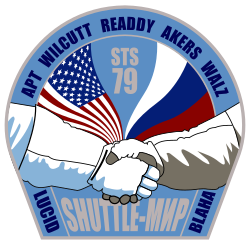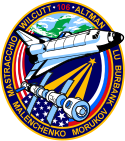Terrence W. Wilcutt
| Terrence Wilcutt | |
|---|---|
 | |
| Land: | USA |
| Organisation: | NASA |
| ausgewählt am | 17. Januar 1990 (13. NASA-Gruppe) |
| Einsätze: | 4 Raumflüge |
| Start des ersten Raumflugs: | 30. September 1994 |
| Landung des letzten Raumflugs: | 20. September 2000 |
| Zeit im Weltraum: | 42d 0h 05m |
| Raumflüge | |
Terrence Wade Wilcutt (* 31. Oktober 1949 in Russellville, Bundesstaat Kentucky, USA) ist ein US-amerikanischer Astronaut.
Wilcutt erhielt 1974 einen Bachelor in Mathematik von der Western Kentucky University und war anschließend Mathematiklehrer an einer High School, bevor er 1976 ins United States Marine Corps eintrat. Er wurde zum Piloten ausgebildet und auf Stützpunkten in Hawaii, Japan, Südkorea und den Philippinen eingesetzt.
Von 1983 bis 1986 war Wilcutt Pilotenausbilder für das Kampfflugzeug F-18 Hornet. Anschließend arbeitete er als Testpilot am Naval Aircraft Test Center in Patuxent River (Maryland).
Astronautentätigkeit
Im Januar 1990 wurde Wilcutt als Astronautenanwärter von der NASA ausgewählt und anschließend zum Shuttle-Piloten ausgebildet. Er ist derzeit stellvertretender Direktor der Abteilung Safety and Mission Assurance am Johnson Space Center.
STS-68
Am 30. September 1994 flog Wilcutt als Pilot mit der Raumfähre Endeavour zum ersten Mal in den Weltraum. STS-68 war der zweite Flug des Space Radar Laboratory. Die zwei Hauptinstrumente an Bord waren das SIR-C/X-SAR (Shuttle Imaging Radar-C/X-Band Synthetic Aperture Radar) und MAPS (Measurement of Air Pollution from Satellites). Am 11. Oktober landete die Raumfähre auf der Edwards Air Force Base in Kalifornien.
STS-79
STS-79 startete am 16. September 1996 zur Raumstation Mir vom Kennedy Space Center, wo die Mission auch später wieder endete. Das Space Shuttle Atlantis war vier Tage an der Raumstation angekoppelt. Bei dieser Mission wurde das Mir-Besatzungsmitglied Shannon Lucid von John Blaha, der mit STS-81 zurückflog, abgelöst. Nach dem Austausch von Versorgungsgütern und Experimenten kehrte die Raumfähre nach zehn Tagen am 26. September auf die Erde zurück.
STS-89
Am 23. Januar 1998 startete Wilcutt als Kommandant der Raumfähre Endeavour zur Raumstation Mir. Eine Aufgabe der Mission war es, den an Bord der Mir befindlichen US-Astronauten David A. Wolf gegen Andrew S. W. Thomas auszutauschen. Außerdem wurden wissenschaftliches Gerät und Versorgungsgüter zur Mir gebracht.
STS-106
Am 8. September 2000 startete Wilcutt als Kommandant der Raumfähre Atlantis zur Internationalen Raumstation (ISS). Hauptaufgaben der Mission waren der Transport von Versorgungsgütern und die Vorbereitung der Station auf die Ankunft der 1. Stammbesatzung. Nach dem Andocken an die ISS unternahmen Juri Malentschenko und Edward Lu einen Weltraumausstieg um zwischen den ISS-Modulen Swesda und Sarja ein Kabel zu verlegen und ein Magnetometer zu installieren. Am 20. September 2000 landete die Mission nach 11 Tagen, 19 Stunden und 12 Minuten auf Cape Canaveral.
Privates
Terrence Wilcutt ist verheiratet und hat zwei Kinder.
Siehe auch
- Liste der bemannten Raumflüge
- Liste der Space-Shuttle-Missionen
- Liste bemannter Missionen zur Raumstation Mir
- Liste bemannter Missionen zur Internationalen Raumstation
- Liste der Raumfahrer
Weblinks
- Kurzbiografie von Terrence W. Wilcutt bei spacefacts.de
- NASA-Biografie von Terrence W. Wilcutt (englisch; PDF)
- Biografie von Terrence W. Wilcutt in der Encyclopedia Astronautica (englisch)
| Personendaten | |
|---|---|
| NAME | Wilcutt, Terrence W. |
| ALTERNATIVNAMEN | Wilcutt, Terrence Wade |
| KURZBESCHREIBUNG | US-amerikanischer Astronaut |
| GEBURTSDATUM | 31. Oktober 1949 |
| GEBURTSORT | Russellville (Kentucky), Kentucky |
Auf dieser Seite verwendete Medien
* In the STS-89 crew insignia, the link between the United States and Russia is symbolically represented by the Space Shuttle Endeavour and Russia's Mir Space Station orbiting above the Bering Strait between Siberia and Alaska. The success of the joint United States-Russian missions is depicted by the Space Shuttle and Mir colored by the rising sun in the background.
- A shadowed representation of the International Space Station (ISS) rising with the sun represents the future program for which the Shuttle-Mir missions are prototypes. The inside rim of the insignia describes the outline of the number eight representing STS-89 as the eighth Shuttle/Mir docking mission.
- The nine stars represent the nine joint missions to be flown of the program and when combined with the number eight in the rim, reflect the mission number. The nine stars also symbolize the children of the crew members who will be the future beneficiaries of the joint development work of the space programs of the two countries.
- Along the rim are the crew members' names with David A. Wolf's name on the left and Andrew S. W. Thomas' name on the right, the returning and upgoing cosmonaut guest researcher crew members. In between and at the bottom is the name of Salizan S. Sharipov, payload specialist representing Russian Space Agency (RSA), in Cyrillic alphabet.
- The other crew members are Terrence W. Wilcutt, commander; Joe F. Edwards, Jr., pilot; and mission specialists Michael P. Anderson, Bonnie J. Dunbar, and James F. Reilly. The red, white and blue of the rim reflect the colors of the American and Russian flags which are also represented in the rim on either side of the joined spacecraft.
Astronaut Terrence W. Wilcutt, commander
Emblem of Nasa's STS-79 mission.
This is the crew patch for the STS-106 mission, which is the first Shuttle flight to the International Space Station since the arrival of its newest component, the Russian-supplied Service Module Zvezda (Russian for star). Zvezda is depicted on the crew patch mated with the already orbiting Node 1 Unity module and Russian-built Functional Cargo Block, called Zarya (sunrise), with a Progress supply vehicle docked to the rear of the Station. The International Space Station is shown in orbit with Earth above as it appears from the perspective of space. The Astronaut Office symbol, a star with three rays of light, provides a connection between the Space Shuttle Atlantis and the Space Station, much the same as the Space Shuttle Program is linked to the International Space Station during its construction and future research operations. Stylized versions of flags from Russia and the United States meet at the Space Station. They symbolize both the cooperation and joint efforts of the two countries during the development and deployment of the permanent outpost in space as well as the close relationship of the American and Russian crew members.
STS-68 Mission Insignia




